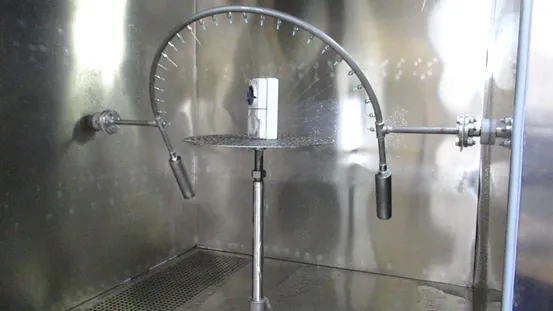BS EN 62262 Mechanical Impact and IP Code Testing
The BS EN 62262 standard provides a framework for assessing the mechanical impact resistance of electronic devices. This testing is essential to ensure that products can withstand accidental impacts without compromising their functionality or causing damage. Ingress protection (IP) ratings, as defined in IEC 60529, are often combined with these tests to provide a comprehensive assessment of the device's durability and safety.
The BS EN 62262 standard covers various types of mechanical impacts, including drops, shocks, and vibrations. It specifies test procedures for determining how devices perform under different impact conditions. These tests are critical in sectors such as consumer electronics, automotive electronics, and industrial equipment where the risk of mechanical damage is high.
When conducting BS EN 62262 testing, it's important to consider the specific IP rating requirements of your product. For example, a device with an IPX1 rating requires only splash protection, while an IPX8-rated device must be able to withstand prolonged submersion in water without malfunctioning.
The testing process typically involves preparing the specimen according to specified dimensions and material properties. Once prepared, the specimen is subjected to mechanical impacts using standardized test equipment. The impact energy and angle are carefully controlled to simulate real-world conditions accurately.
After each test, thorough inspections of the specimen are conducted to ensure that no damage has occurred. This includes visual checks, electrical continuity tests, and functional performance evaluations. Any deviations from expected results or failures during testing are documented in detail for analysis.
The BS EN 62262 standard also emphasizes the importance of maintaining accurate records throughout the testing process. These records should include all test parameters, conditions, observations, and conclusions drawn from the tests. This documentation is crucial for compliance purposes and future reference.
In addition to mechanical impact resistance, IP ratings play a significant role in determining a product's suitability for specific environments. For instance, an IPX7-rated device can operate safely underwater up to 1 meter depth, making it ideal for applications like waterproof cameras or industrial sensors.
By adhering to the BS EN 62262 standard and ensuring compliance with appropriate IP ratings, manufacturers can enhance their products' reliability and safety. This not only protects consumers but also helps companies meet regulatory requirements worldwide.
| Applied Standards |
|---|
| BS EN 62262 (Mechanical Impact Resistance of Electrical and Electronic Equipment) |
| IEC 60529 (Protection Degrees (IP Code)) |
Applied Standards
- BS EN 62262: Provides detailed specifications for mechanical impact resistance of electrical and electronic equipment.
- IEC 60529: Defines the IP ratings used to classify the protection provided by enclosures against access to hazardous parts, ingress of solid objects, water ingress, etc.
Why Choose This Test
- The BS EN 62262 standard ensures that electronic devices can withstand accidental mechanical impacts without failure.
- IP ratings help manufacturers design products suitable for diverse environments, enhancing their marketability and safety.
- This testing process helps identify potential weaknesses in product design early on, allowing for necessary improvements before mass production.
Competitive Advantage and Market Impact
- Compliance with BS EN 62262 demonstrates a commitment to quality and safety, setting your brand apart from competitors.
- Meeting IP rating requirements ensures that your products are suitable for various environments, broadening their potential market reach.
- Data generated through these tests can be used in marketing materials, enhancing customer confidence and trust.





